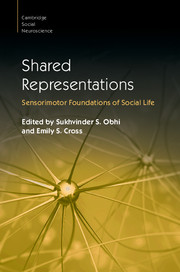Book contents
- Shared Representations
- Cambridge Social Neuroscience
- Shared Representations
- Copyright page
- Contents
- Figures
- Tables
- Boxes
- Contributors
- Preface
- Part I Foundations
- Part II Imitation and Mimicry
- Part III Thinking, Perceiving and Acting with Others
- Part IV Understanding Others
- Part V Learning and Development
- 21 Shared Interoceptive Representations
- 22 Mirror Neuron Formation via Associative Learning
- 23 Disorders of Shared Representations
- 24 Learning by Diffusion
- 25 Observational Motor Learning
- 26 The Impact of Action Expertise on Shared Representations
- Part VI Shared Representations in Applied Contexts
- Index
- Plate Section (PDF Only)
- References
22 - Mirror Neuron Formation via Associative Learning
from Part V - Learning and Development
Published online by Cambridge University Press: 27 October 2016
- Shared Representations
- Cambridge Social Neuroscience
- Shared Representations
- Copyright page
- Contents
- Figures
- Tables
- Boxes
- Contributors
- Preface
- Part I Foundations
- Part II Imitation and Mimicry
- Part III Thinking, Perceiving and Acting with Others
- Part IV Understanding Others
- Part V Learning and Development
- 21 Shared Interoceptive Representations
- 22 Mirror Neuron Formation via Associative Learning
- 23 Disorders of Shared Representations
- 24 Learning by Diffusion
- 25 Observational Motor Learning
- 26 The Impact of Action Expertise on Shared Representations
- Part VI Shared Representations in Applied Contexts
- Index
- Plate Section (PDF Only)
- References
Summary
This volume discusses the evidence for – and implications of – the existence of shared representations in the human brain. When we perceive another person’s actions, emotional states or even tactile sensations, we activate the same motor programs, emotional circuitry and somatosensory networks that would be active if we were to perform those actions, or feel those emotions or sensations. Thus our own representation of an action, emotion or sensation becomes ‘shared’: activated not only by our own action, emotion or touch, but also by the perception of the same events in other people. There is now extensive evidence, discussed in earlier chapters, for the presence of such ‘shared representations’; in contrast, what this chapter addresses is how the brain acquires these shared representations. In this chapter, I focus on shared representations of action, as instantiated by mirror neurons. This is because historically it is shared action representations that have been subject to the most investigation; however, I will conclude with some thoughts on how this work may generalize to other types of shared representation.
- Type
- Chapter
- Information
- Shared RepresentationsSensorimotor Foundations of Social Life, pp. 460 - 479Publisher: Cambridge University PressPrint publication year: 2016



